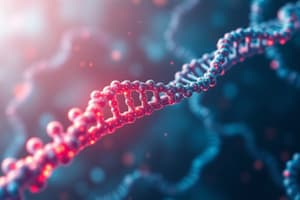Podcast
Questions and Answers
Frederick Sanger's work significantly advanced which fields?
Frederick Sanger's work significantly advanced which fields?
- Only genetic manipulation.
- Only medicine and gene therapy.
- Medicine, gene therapy, and genetic manipulation. (correct)
- Molecular biology exclusively.
Sanger's undergraduate degree influenced him to pursue?
Sanger's undergraduate degree influenced him to pursue?
- Rural general practice, following his father’s path.
- Advanced biochemistry, deviating from natural sciences.
- Biochemistry, marking the start of his scientific career. (correct)
- Applied research on nitrogen uptake in potatoes.
What critical insight did Sanger's work on insulin reveal about proteins?
What critical insight did Sanger's work on insulin reveal about proteins?
- All proteins share a universal 3D structure.
- Each protein has a unique amino acid sequence and 3D structure. (correct)
- Proteins are composed of identical amino acid sets.
- Proteins lack a defined amino acid sequence.
How did Sanger's Quaker beliefs influence his actions during World War II?
How did Sanger's Quaker beliefs influence his actions during World War II?
Which factor did Sanger identify as a cornerstone of his research methodology?
Which factor did Sanger identify as a cornerstone of his research methodology?
What was the primary focus of Sanger's doctoral research?
What was the primary focus of Sanger's doctoral research?
In what year did the Wellcome Sanger Institute, named in Sanger's honor, open its doors in Cambridge, UK?
In what year did the Wellcome Sanger Institute, named in Sanger's honor, open its doors in Cambridge, UK?
What is the significance of the dideoxy method developed by Sanger?
What is the significance of the dideoxy method developed by Sanger?
Which polymers of life did Sanger sequence the components of?
Which polymers of life did Sanger sequence the components of?
What specific applied research did Sanger conduct in lieu of military service during World War II?
What specific applied research did Sanger conduct in lieu of military service during World War II?
What key challenge did Sanger overcome to sequence DNA effectively in the 1970s?
What key challenge did Sanger overcome to sequence DNA effectively in the 1970s?
How did Sanger's method of sequencing using radioactive isotopes contribute to understanding genetic material?
How did Sanger's method of sequencing using radioactive isotopes contribute to understanding genetic material?
What was the significance of sequencing the Caenorhabditis elegans genome, spearheaded by John Sulston?
What was the significance of sequencing the Caenorhabditis elegans genome, spearheaded by John Sulston?
How did Sanger's method of dideoxy chain-termination contribute to the field of genetics?
How did Sanger's method of dideoxy chain-termination contribute to the field of genetics?
In what way did Frederick Sanger's work influence the development of treatments for diabetes?
In what way did Frederick Sanger's work influence the development of treatments for diabetes?
How did Sanger's early work with RNA contribute to his later DNA sequencing achievements?
How did Sanger's early work with RNA contribute to his later DNA sequencing achievements?
What was the key innovation in Sanger's sequencing method that allowed for the ordering of DNA strands?
What was the key innovation in Sanger's sequencing method that allowed for the ordering of DNA strands?
According to the information, how did Sanger's sequencing method directly impact the treatment of genetic disorders?
According to the information, how did Sanger's sequencing method directly impact the treatment of genetic disorders?
What unique characteristic of Caenorhabditis elegans made it an ideal organism for genetic sequencing, as highlighted by Sulston's research?
What unique characteristic of Caenorhabditis elegans made it an ideal organism for genetic sequencing, as highlighted by Sulston's research?
How did Sanger's sequencing of the DNA of cell mitochondria in 1981 advance genomic research?
How did Sanger's sequencing of the DNA of cell mitochondria in 1981 advance genomic research?
Flashcards
Who was Frederick Sanger?
Who was Frederick Sanger?
An experimental biochemist who sequenced proteins, RNA, and DNA.
What is Sanger Sequencing?
What is Sanger Sequencing?
Sanger's method for sequencing DNA, published in 1977.
Where is the Wellcome Sanger Institute?
Where is the Wellcome Sanger Institute?
Cambridge University, UK, in 1993.
What Nobel Prize did Sanger receive for sequencing insulin?
What Nobel Prize did Sanger receive for sequencing insulin?
Signup and view all the flashcards
When did Sanger receive his Ph.D.?
When did Sanger receive his Ph.D.?
Signup and view all the flashcards
Which fundamental polymers of life did Sanger sequence?
Which fundamental polymers of life did Sanger sequence?
Signup and view all the flashcards
What revolutionized molecular biology?
What revolutionized molecular biology?
Signup and view all the flashcards
What was Sanger's second Nobel Prize?
What was Sanger's second Nobel Prize?
Signup and view all the flashcards
During WWII, what research did Sanger conduct?
During WWII, what research did Sanger conduct?
Signup and view all the flashcards
What did Sanger determine about proteins?
What did Sanger determine about proteins?
Signup and view all the flashcards
Sanger Sequencing
Sanger Sequencing
Signup and view all the flashcards
Who was John Sulston?
Who was John Sulston?
Signup and view all the flashcards
Sanger's sequencing method enabled what?
Sanger's sequencing method enabled what?
Signup and view all the flashcards
What animal did Sulston sequence?
What animal did Sulston sequence?
Signup and view all the flashcards
Sanger's protein sequencing led to...
Sanger's protein sequencing led to...
Signup and view all the flashcards
Study Notes
- The first protein was sequenced, followed by a surge in protein research.
- This surge enabled the development of synthetic insulin for treating diabetes.
- Following receipt of the Nobel Prize in Chemistry in 1958 for work on insulin Sanger had the freedom to pursue his most ambitious research goals.
- In1962, Sanger moved to the Laboratory of Molecular Biology in Cambridge.
- He turned his attention to exploring the structure of genetic nucleic acids, RNA, and DNA, after catching what he called "the sequencing bug".
- Sanger's Cambridge colleagues Francis Crick and James Watson discovered the double-helix structure of DNA in 1953.
- Sanger aimed to untangle this DNA structure to reveal the bases in specific strands, each carrying a distinct genetic code.
- Sanger began with RNA, a smaller and less complex single-stranded nucleic acid.
- According to the information encoded in DNA, Sanger developed a sequencing method using radioactive isotopes to "label" individual fragments.
- Sanger’s method built the sequence by looking at areas of overlap between individual fragments.
- By 1967, Sanger had a complete sequence of RNA from E. coli bacteria.
- In the early 1970s, Sanger moved on to DNA sequencing, which was more difficult due to DNA's size and double-helix structure.
- Sanger’s team pioneered a method of isolating DNA fragments via dideoxy chain-termination in 1977 which uses a molecular inhibitor to prevent DNA strands from extending.
- These strands could then be ordered from shortest to longest, allowing the base sequence to be read.
- This method enabled Sanger to map the first human genome, the DNA of cell mitochondria, in 1981.
- Sanger’s work led to the sequencing of all 3 billion base pairs of the entire human genome.
- Sanger's sequencing method allowed fragments of DNA to be isolated, cloned, and reattached to create modified genes for treating or resisting genetic disorders.
Additional information
- Frederick Sanger quoted in 2001: "I had 20 years when I could just do what I wanted."
- By 1982, 48,502 base pairs of DNA had been sequenced.
John Sulston
- English biologist John Sulston was the first director of the Wellcome Sanger Institute genome research center.
- Sulston shared the 2002 Nobel Prize for work on programmed cell death.
- Sulston's research centered on Caenorhabditis elegans, a 0.03-in (1-mm) nematode worm, from 1942-2018.
- This worm has an exact number of cells, making it ideal for studying cell differentiation, division, and programmed death.
- Sulston pushed for the genetic sequencing of C. elegans, which became the first animal to have its entire genome sequenced in 1988.
- This led directly to the Human Genome Project (1990-2003), in which Sulston was a key contributor.
Studying That Suits You
Use AI to generate personalized quizzes and flashcards to suit your learning preferences.



